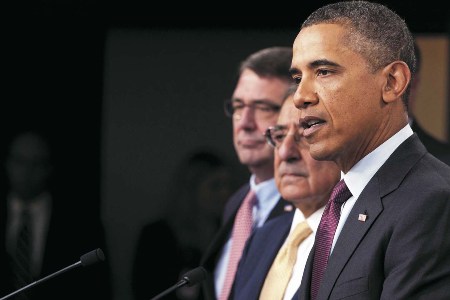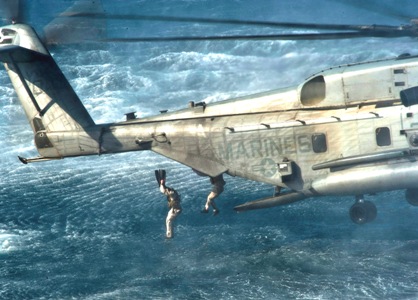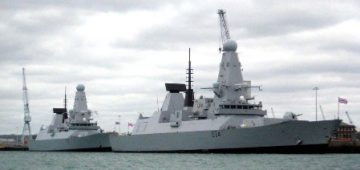SPECIAL REPORT
- Carriers and amphibs preserved
- Boost to submarine forces investment
- New sea-basing ‘barges’ for Spec Ops
- Less emphasis on Europe as forces shift to Asia-Pacific
- Older guided-missile cruisers and assault ships axed
- Replacement SSBN programme slowed down to reduce costs
- US Marines to lose 20,000 troops
- Destroyer forced maintained
- Forward bases for ships in Bahrain and Singapore
- F-35 survives in both USMC and USN variants
Report by Iain Ballantyne
The US Navy will retire cruisers early and lose some elderly amphibious warfare vessels, while also suffering a trim of 20,000 personnel in the US Marine Corps, but it sees strike carriers and amphibious readiness groups retained.
On the same day as it was revealed (Jan 26) US Navy SEALS had successfully mounted a daring rescue mission into Somalia to rescue two aid workers held hostage by pirates, US Secretary of State for Defense Leon Panetta said of the future for the USA’s military: “We will emphasize Special Operations forces.”
And that means maintaining the naval launch pads for their missions and pursuing a global maritime defence that ensures there are no more long-term, and very costly, commitments on land, such as Afghanistan and Iraq.
In discussing the changes during a Pentagon briefing the Secretary explained they would entail “retaining the most flexible, versatile and technologically advanced platforms that we will need for the future.” He went on: “ That involves unmanned systems, satellites, submarines, helicopters, aircraft carriers and fifth-generation aircraft. What we’re looking at are multi-mission weaponry and technology that can support that kind of agile force.”
The US Marines Corps manpower strength currently stands at 202,000 ‘active-duty members’ and this will decline to 182,000 over the next five years, while the US Army will shrink from regular forces strength of 562,000 today to 490,00. Secretary Panetta pointed out the USA will still possess more armed forces than it maintained before 9-11. The US Department of Defense says the current level of commitment to Central Command will but there will, as predicted, be an increased force, and level of commitment to the Asia-Pacific region. A plan to forward-base Littoral Combat Ships (LCS) in Singapore was confirmed, but it was revealed that some of the new vessels would operate from Bahrain, too. In explaining the rationale behind sticking with maintaining strike carriers as the ‘big stick’ of American military power, Vice Chairman of the Joint Chiefs of Staff Admiral James Winnefeld said: “We carefully examined inside the Department [of Defense] and in fact consulted with the White House, and everybody is in agreement that the capability, the flexibility, the independent capability of a carrier from basing, the applicability of that ship in an anti-access environment and its particularly useful role in the Middle East and the Pacific, which is where we have emphasized most of the regional strategic focus here, just makes it a particularly adept platform for the type of things we want to do strategically in the future. And we saw it just didn’t make sense to take out any carrier force structure, and so we’re going to stick with 11 carriers and 10 air wings.”
However, for observers elsewhere – particularly in France and Britain, the only two other nations currently with plans to field super-carrier strike forces – this did not mean they could relax. The increased American emphasis on Asia-Pacific, where the Chinese are working up their plans for carriers, and the Russian aim to dominate the Arctic via assault carriers and strike platforms, requires that American allies step up to the plate. European nations also have critical strategic interests East of Suez and in Asia-Pacific. To that end the British Secretary of State for Defence recently agreed a strike carrier regeneration programme with the USA. Meanwhile, construction of two new carriers, Queen Elizabeth and Prince of Wales, steadily progresses. In the absence of any extant UK carrier strike capability (until 2020 at least) the French and British also have a fledgling carrier sharing deal.
In seeking to also project force in the absence of available strike carriers or amphibious ships, the Pentagon has confirmed an innovative sea-basing initiative.
A programme to construct gigantic floating Special Operations platforms – gigantic barges, or floating airfields – is to go ahead.
On the pain side, seven of the older Ticonderoga Class cruisers, dating from the 1980s, will be decommissioned, while two amphibious warfare ships are to be retired from service early. Secretary Panetta did, however, make a forthright commitment to submarines as a key part of the US Navy present and future.
“Modernizing our submarine fleet will also be critical to our efforts to maintain maritime access in the vital regions of the world,” he said at the Pentagon briefing. “In this budget, the Navy will invest in a design that will allow new Virginia class submarines to be modified to carry more cruise missiles and develop an undersea conventional prompt strike option.”
On the flipside of the submarine coin, though, the USA is saving money buy imposing a delay in its programme to replace its Ohio Class ballistic missile submarines. The Secretary revealed: “Our review determined that we could achieve better cost control by delaying the next-generation ballistic missile submarine for two years without harming the survivability of our nuclear deterrent. We are fully committed to a safe, secure and effective deterrent to achieve national security objectives.”
This may make everything more in synch with the UK, which is relying on the USA to supply a new generation of missiles for its future SSBNs, but is also keen to save money. However, the British do not have such an expansive programme of SSN construction as the US Navy. There must be some interested observes in the UK who wonder how skill-fade of the kind that almost crippled the Astute Class attack boat programme will be avoided. For the UK then, keeping pace with the Americans may well prove extremely costly in the long run, even if it avoids political problems and saves money in the short-term.
Justifying the USA’s decision to slow down its SSBN replacement programme, Deputy Secretary of Defense Ashton Carter explained: “The initial cost estimates for the Ohio Class replacement came in quite high, unacceptably high, so high that they would, in the decade 2020 to 2030, consume a disproportionate share of the Navy shipbuilding budget.” He added: “We worked very hard on the requirements, saying, ‘do we really need this?’ Do we really need that?”

He explained the US Navy decided to work “very aggressively on the requirements”. and this entailed amending the design and also looking at “the drivers of cost in the design and [therefore an ability to] manage the cost down. “ Mr Carter also said on the matter of future SSBNs: “And that was done from a figure well in excess of 6 billion [dollars] per boat to the neighbourhood of 5 billion [dollars] per boat. That’s the goal.” This sort of discipline would also apply to other American military programmes. Mr Carter said: “We’re going to have to ask ourselves, in this kind of budgetary environment, how much is good enough? Is the 80 percent solution sufficient? And that’s what was done with the Ohio Class replacement. And that, I think, is going to be successful, and that’s the reason why it will be affordable.”
Europe is rapidly becoming of peripheral concern to the USA, as articulated by Admiral Winnefeld, who explained that while there would be a reduction in USN cruisers and logistical support vessels, it would not harm the nation’s strategic posture. “You’re going to find a gradual shift in the Navy’s force structure from east to west,” he pointed out, “and so, in terms of aircraft carriers, submarines, logistic ships and the like, you’ll see that gradually flowing over there [to Asia-Pacific].”
The revised global orientation for US military forces is based on a strategy document, entitled ‘Sustaining U.S. Global Leadership: Priorities for 21st Century Defence’, which was published in early January. It includes explanations of the different elements of the new posture, including the intention to ‘Deter and Defeat Aggression’.
The document explains: ‘U.S. forces will be capable of deterring and defeating aggression by any potential adversary. Credible deterrence results from both the capabilities to deny an aggressor the prospect of achieving his objectives and from the complementary capability to impose unacceptable costs on the aggressor. As a nation with important interests in multiple regions, our forces must be capable of deterring and defeating aggression by an opportunistic adversary in one region even when our forces are committed to a large-scale operation elsewhere. Our planning envisages forces that are able to fully deny a capable state’s aggressive objectives in one region by conducting a combined arms campaign across all domains, land, air, maritime, space, and cyberspace.’
During remarks on the context of the DSR, President Obama noted that an opportunity was being provided by the draw down of commitments in Iraq and Afghanistan to give the USA the sort of flexible, but highly capable, armed forces it truly needs. He also explained that while the review was not just cost driven, it would play a major part in getting the USA’s finances on a more even keel.
“Now we’re turning the page on a decade of war,” said the President. “Three years ago, we had some 180,000 troops in Iraq and Afghanistan. Today, we’ve cut that number in half. And as the transition in Afghanistan continues, more of our troops will continue to come home.”
He said later: “Even as our forces prevail in today’s missions, we have the opportunity – and the responsibility – to look ahead to the force that we are going to need in the future. At the same time, we have to renew our economic strength here at home, which is the foundation of our strength around the world. And that includes putting our fiscal house in order.” Similar major defence reviews, in the wake of WW2 and the Vietnam War, left the USA poorly positioned to cope with the Korean War, in the first instance, and ‘hollowed out’ in capability terms between 1975 and the early 1980s. President Obama said those mistakes would not be repeated: “the size and the structure of our military and defence budgets have to be driven by a strategy, not the other way around.”
He added: “As Commander-in-Chief, I will not let that happen again. Not on my watch. We need a start – we need a smart, strategic set of priorities.”
Presaging the areas that would be hit hard by the cuts, which will total US $487 billion between 2012 and 2022, the Defense Secretary revealed: “the Army and Marine Corps will no longer need to be sized to support the kind of large-scale, long-term stability operations that have dominated military priorities and force generation over the past decade.” Making his own reflections on the balance between achieving economies while preserving capabilities and strategic reach needed to act where necessary, Secretary Panetta conceded: “There is no doubt that the fiscal situation this country faces is difficult, and in many ways we are at a crisis point.” However, he felt, “in every crisis there is opportunity.” Expanding on this point, he said: “Out of this crisis, we have the opportunity to end the old ways of doing business and to build a modern force for the 21st Century that can win today’s wars and successfully confront any enemy, and respond to any threat and any challenge of the future. Our responsibility – my responsibility as Secretary of Defense – is to protect the nation’s security and to keep America safe. With this joint force, I am confident that we can effectively defend the United States of America.”
One programme seemingly under threat was the F-35 strike fighter, or elements of it. In announcing details of cuts at the end of January Secretary Panetta revealed that elements of the programme had been slowed to make sure full testing could be carried out. It was also confirmed by the Pentagon that the STOVL variant of the F-35 is back on track. It had been thought vulnerable, something that would hit the US Marines hard as they would then have no strike fighter to fly from their assault carriers. Deputy Secretary Carter was able to announce that getting the F-35B back on track was “the result of some good engineering work done in the last year … and that means all three variants can go forward.”
The others are the F-35A, for the US Air Force, and the F-35C for the US Navy (and also for the Royal Navy’s new carriers). However, there remain problems with costs and performance, which still need to be ironed out, he said, adding that there are still problems with programme’s cost and performance. The US Navy remains a big fan of the F-35, Admiral Winnefeld enthusing: “It’s a terrific airplane. We’re very committed to it and it does represent the future of tactical aviation for this country and a lot of our partners. We just need the manufacturability of this thing to catch up so we can start buying. We’re very anxious to get it into the fleet.”
Pictured:

President of the United States Barack Obama delivers a press briefing on defence cuts along with Secretary of Defense Leon Panetta and General Martin Dempsey, Chairman of the Joint Chiefs of Staff, at the Pentagon on January 5, 2012. Photo: Erin A. Kirk-Cuomo/US DoD.


Forces fit for the USA’s future defence needs: In the Arabian Sea on January 19 this year American marines conduct insertion exercises from a CH-53E Super Stallion helicopter. Their parent unit, the 11th MEU was embarked aboard the assault carrier USS Makin Island. Photo: Alan Gragg/US Navy.






Comments
Sorry, comments are closed for this item